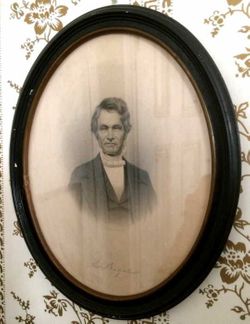

Children of Asa 6 and Lucy (ISHAM) BIGELOW:
16312.71 Susan Emeline,
born 05 Dec 1805 Colebrook,CT; d 13 Feb 1884 Malden, NY; m 01 Jan
1822 Stephen D. Kellogg of Troy, NY; res Malden, NY (Stephen
drowned 04 Oct 1848 Malden)
16312.72 Edward, b 20 Aug 1810 Saugerties,NY; died there 23 July 1889; m (1) Caroline E. BOIES, and (2) 27 Jun 1853 Mary Ann BOIES. 9 children. CT.
16312.73 David, b 26 June 1815 Malden, NY; d ___ ; m 11 June 184_ Maria Van Allen, dau of Lucas J. and Elizabeth (Van der Pool) Van Allen, b 17 Aug 1817 Kinderhook, NY; res Malden, NY; No issue.
16312.74 John, b 15 Nov 1817 Malden, NY; d 19 Dec 1911 NY; m 11 Jun 1850 Jennie POULTNEY; resided both NY and abroad, as he was U.S. consul in France and held other foreign posts. 6 children.
16312.75 Adeline,b 26 Dec 1823 Malden,NY; d 23 Dec 1850 Malden; m 20 Oct 1847 Henry H. Beers.
Sources:
Bigelow Society,The Bigelow Family Genealogy Vol I, pg 322.
Howe, Bigelow Family of America; pg 249;
Biographical Encyclopedia of U.S.
Clapp, Forgotten First Citizen.
April 2001 FORGE: The Bigelow Society Quarterly Vol. 30,
No.2 (see link)
descendant note:
My relatives were Ishams. My mother was born at Malden on
Hudson. I have been there many times. I have
photographs of the brick store, and the Bigelow Bluestone office
just north of the brick store. They had a paper mill there,
huge ice house, and holdings in New York City, on Gold
Street......I also have the land records purchaces from Colebrook
CT, and Canaan, CT. I ran across them while researching
Isham, Fitzgerald, Stillman, and a few others. I also have
some letterhead of the Bluestone Company.....Ran across your
website by accident. Glad I did. It filled in some
blanks for me.
Dominic Bruno email 2ilona@gte.net
more from Dominic....
I have pictures of the Bigalow Bluestone Co. taken 15 years
ago. It is still standing and is a private residence.
I also have an old photo of the grist mill, and the original brick
building that Asa put up. My earliest photo is about
1905. It was then the Isham store. My folks left about
1915 and came to CT. I visited the place several times. My
Uncle was born in the living area upstairs over the store.
Mr Richard Peetem owns it now. They let me go inside.
There was a bar in the cellar which would have been the origional
store. The bar must have been built after 1915. There
was still a Bigelow living on the same street as the brick
building. If any of the photos or text I got from the books in
Sauggerties are of interest, I will make them available. I am
looking for the parents of Patience Foote who married Asa
(16312.7) if you know?
John 7 Bigelow's Speech by Ric Dragon. This speech talks about his father Asa, the ISHAMS, Fulton's Steamboat, and life of the times. I will paste an excerpt here:
"I will allow myself to say a few words about the only native of Marlborough I can pretend to have ever personally known since I was seven or eight years of age, until a few hours visit here a year ago.
My father, Asa Bigelow, was born in this town on the 18th of January, 1779, and died on the 12th of February, 1850, at Malden, in his seventy-first year. On the 18th of February, 1802, he was married to Lucy Isham, of Colchester, Conn., by the Reverend Salmon Cone; she in her twenty-second and he in his twenty-third year.
My father had three brothers and three sisters. Of these, my namesake, John D., who lived to the goodly age of a century, and his brother Isaac, lived and died in Marlborough. David settled in Vermont and Erastus in Union Village, Washington Co., New York. One of the sisters married John Sears, a Baptist clergyman, and moved to western New York; the other two sisters were settled in this town and are represented here today by their offspring.
My father soon after his marriage migrated to what is now known as the town of Saugerties, then an obscure village near the banks of the Hudson River, on what was known in my youth as the Sawyer's Creek [editor's note; at this point, someone has annotated that it is "Sawmill Creek"] , where to a general country store he added the business of freighting and forwarding the produce of the neighborhood to New York. He secured the first post-office service for the village of Saugerties, and he himself its first postmaster. He was appointed by President Jefferson."
Asa BIGELOW Father of John7 BIGELOW, by Ric Dragon ( author of THE BIGELOW PAGE)The picture left above, excerpt above, and article below are his. They are fine examples of genealogical research.
Sylvester, Nathaniel Bartlett. History of Ulster County, New York. [Philadelphia: Everts & Peck, 1880], Interlaken, NY: Heart of the Lakes Publishing, 1994, pp. 74a-74b, 74d-74e.
Asa Bigelow
Asa, the first settler of the name of Bigelow in Ulster County , was a son of David and Patience Bigelow, and was born at Marlborough, in the State of Connecticut, on the 18th day of January, 1779. John Baguley, or Bigelow, the ancestor of the numerous families of Bigelows in New England, came from Cheshire, England, to Watertown, in the colony of Massachusetts, where on the 30th day of October, 1642, he married Mary Warren, who was also born in England. He died July 14, 1703, aged eighty-six years. He left twelve children. Several of his grandchildren settled in Marlborough, Mass. His son John, born in 1643, and grandson Isaac, born in 1690, settled in Connecticut. They are presumed to be among the early settlers of the town of Marlborough, in the State of Connecticut, and to have brought with them to their new home the name of the place which one of them at least had left, and which was consecrated to both by the tenderest associations.Asa Bigelow's grandfather, David Bigelow, died at Marlborough, on the 2nd of June, 1799, in the ninety-third year of his age. His grandmother, Mary, died January 5, 1795, in the eighty-sixth year of her age.
While yet a lad of fourteen, Asa entered the store of David Kilbourn, a merchant in the town of Farmington, in the State of Connecticut, and was at the same time received into Mr. Kilbourn's family on the footing of a son. His school education was limited to four winter months' attendance at the district school in that place.
He remained with Mr. Kilbourn till he became of age, when he opened a store on his own account in the town of Colebrook. While residing there, and on the 18th day of February, 1802, he married Lucy Isham, a daughter of Samuel and Mary Isham, of Colchester, who was a Miss Adams, - he in his twenty-third and his wife in her twenty-second year. He was reasonably successful in his business, and in the course of four or five years accumulated a few hundred dollars, but, fancying there was a wider sphere of action for young men in the "far West," he mounted his horse one day, and, with all the money of which he was possessed stuffed into his saddle-bags, started for the State of New York, - the "far West" of that period, - accompanied on another horse by his brother-in-law, Dr. Roswell Bradley, who had married Mrs. Asa Bigelow's sister, Sally Isham. The pilgrims crossed the Hudson River at Catskill, and traveled southward along its west branch as far as Flatbush. Here Mr. Bigelow was inclined to purchase a tract of land on the river and settle, but upon a more careful study of the situation concluded to return to the Dutch settlement at Saugerties, some eight miles farther north. He there purchased the house and store on the corner of Main Street now known as Russell's Block, - to-day perhaps the most valuable piece of land of its size in the town, - and commenced a general shipping and commission business. He bought or advanced on the produce of the surrounding country, which he shipped to the New York market and sold, making his settlements largely in merchandise. He was quite prosperous, and seems very soon to have been recognized as one of the leading men of the county.
In 1811 the county of Greene was carved out of the counties of Ulster and Albany, and at the same time Saugerties, theretofore a part of the town of Kingston, was itself incorporated into a town. Mr. Bigelow was elected the second supervisor of the new town , and was re-elected every year till he took up his residence elsewhere. Upon his application, a post-office was established at Saugerties, and he was its first postmaster. He continued to hold this office also till he moved to Bristol, now called Malden, about two miles north of Saugerties. The navigation of Saugerties Creek in those days was subject to serious interruptions from freshets and shoals, which proved such an inconvenience to his business that after five years' experience Mr. Bigelow determined to go two miles farther north, where he could have his dock privileges and warehouse directly on the river, with plenty of water.
This section of Ulster County had been originally settled by German refugees from the Palatinate, who found an asylum from the persecutions of Louis XIV. along the banks of the Hudson River, between Kingston and Catskill. They were a simple-minded people, living mostly upon the products of their land, which was but poorly tilled, and upon the fish with which in those days the waters of the Hudson teemed. They had little enterprise, disliked all Yankee novelties, and discouraged what the Yankees considered improvements. They rapidly diminished in numbers, their descendants having to a considerable extent disappeared, leaving scarcely any durable traces of their existence behind them. The only house in Bristol, when Mr. Bigelow arrived there, was an old fish-house, which stood upon the site now occupied by the Malden House.
He had purchased from the heirs of John Wolven, in 1808, a tract of about two hundred acres, for which he paid six thousand dollars.* This land, or most of it, is now the property of Mr. Francis Pigeon.
*(Asa 6 Bigelow's purchase of 200 acres of land from one John WOLVEN is mentioned. The price was $6,000. I am interested in the WOLVEN family tree. Have you come across anything that would be helpful to me; from Greg Advocaat 1239 Saffron Lane SE, Apt 3A Grand Rapids, MI 49508 advocaat@iserv.net)
Upon the upper end of this property he built a frame store, on the south side of the road leading to what is now known as the Isham wharf . He erected for his own use the first dwelling-house in the place, which is now occupied by Jeremiah Parris. Soon after settling there he commenced building the brick store into which he moved in 1814. Four years later he took his brothers-in-law, Charles and Giles Isham, into partnership with him, under the firm-name of Bigelow & Isham. Giles Isham had been his clerk for several years previous. Not long after this partnership was formed Mr. Bigelow withdrew from it, built the stone store on a property adjoining on the north, that which the firm had occupied, and which he purchased from John Van Steenberg on the 22nd day of June, 1813. Its water-privileges constituted its chief value. Here he re-established himself, first alone, and afterwards associated with him his son-in-law, Stephen Kellogg, and his two oldest sons, Edward and David. He here prosecuted a prosperous business till he retired with a handsome competence about 1846.Though diligent in business, Mr. Bigelow did not forget or neglect his duties to the public. He erected the first two hotels in Bristol; he procured the establishment of a post-office in the place, which led to a change of its name to Malden, and the appointment of one of his clerks, Judson H. Calkins, as postmaster. He, with his two brothers-in-law, bore almost the entire expense of constructing the first church and parsonage in Malden. He procured the charter for the turnpike which unites Malden with the mountain settlements in its rear, and furnished most, if not all the money for building it. He also built the first academy in Malden, and the first sloop that was ever constructed in the town of Saugerties. She was called the "Phnix," and plied between Bristol and New York.
Mr. Bigelow's habits of business bore the impress of strong individuality, and go far to explain his uninterrupted success as a merchant, and his influence in whatever community he was a citizen. He never bought what he could not pay for at the time; he never gave a note in his life, nor endorsed but one, and that he had to pay. It was for one hundred and fifty dollars, in behalf of a relative, and before he left Connecticut. This note is still in the family. He often spoke of this as one of the indiscretions of his youth, but at the same time he regarded the money it cost him as the best investment he ever made, for it cured him for life of any disposition to use or lend his financial credit. It is needless to say that there was no house on the Hudson in better financial standing.
During the war of 1812 the scarcity of currency compelled him to issue his own paper in the form of currency, redeemable on presentation, for the convenience of his customers. The venerable Peter Schutt, who is now one of the two or three oldest inhabitants of the town of Saugerties, says he remembers when the Bigelow "shinplasters were the only currency in the place," adding, "And we were all glad enough to get them."
Mr. Bigelow was educated in the Presbyterian faith, and during the last twenty years of his life was a consistent professor of religion. Though he had enjoyed the most limited opportunities for education, Mr. Bigelow was so liberally endowed in every way by nature that he was sure to occupy a prominent place in whatever sphere of life he might be placed. He was about six feet two inches high, and of prodigious strength in early manhood. He died on the 12th day of February, 1850, in the seventy-second year of his age, leaving six children, - Emmeline, who was born in Colebrook, and married Stephen Kellogg, of Troy; Edward, who was born in Saugerties; and David, John, and Adeline, who were born in Bristol.
Mrs. Asa Bigelow survived her husband three years, dying at her residence in Malden, Sept. 14, 1853, in the seventy-third year of her age.Below: Old pictures of Bigelow residence in Malden-on-Hudson, once owned by Asa and later owned by descendants John and his son Poultney. Courtesy of Ric Dragon and The Bigelow Museum.

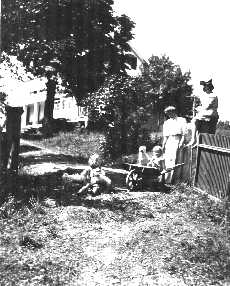
oldpic1.jpg oldpic2.jpg
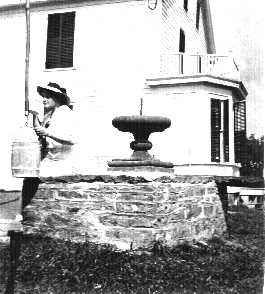
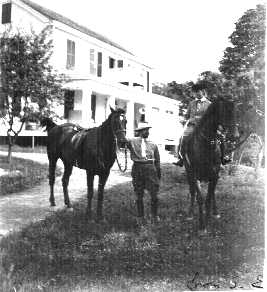
oldpic3.jpg oldpic4.jpg
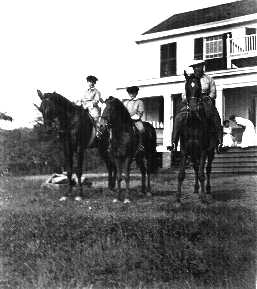
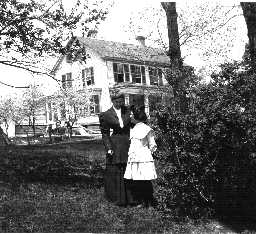
oldpic5.jpg oldpic6.jpg

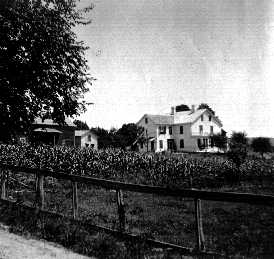
oldpic7.jpg oldpic8.jpg

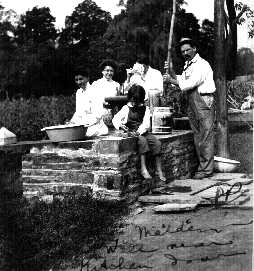
oldpic9.jpg oldpic10.jpgBiographical Information
Constantine Sidamon-Eristoff, an environmental attorney from New York City and Highland Falls, New York joined Lacher & Lovell-Taylor in October, 1999. From 1989 to 1993 he served as Regional Administrator for Region II of the United States Environmental Protection Agency under Administrator Reilly during the administration of President Bush. Region II encompasses New York, New Jersey, Puerto Rico and the U.S. Virgin Islands and administers, with a staff of some thousand employees, EPA's programs for the control of air and water pollution, industrial discharges, toxic substances, pesticides, ocean dumping, hazardous wastes, as well as the Federal "Superfund" for the cleanup of hazardous waste sites.
He is on the Advisory Board of the Metropolitan Association of Urban Designers and Environmental Planners, Inc.; of the Project for Public Spaces, and of Civitas of the East Side, New York City. He was for many years a member of the Committee on Transportation Law - Legal Resources Group Council of the Transportation Research Board in Washington, D.C., and has been the Chairman of its subcommittee on mass transit.
Mr. Sidamon-Eristoff is married to the former Anne Phipps. They have three children: Simon; Elizabeth and Andrew, and eight grandchildren.
Addresses
120 East End Avenue Apt. 12B
New York, NY 10028
Tel: 212-988-2261
Fax:212 734-2659
email address: c.sidamoneristoff@worldnet.att.net <c.sidamoneristoff@worldnet.att.net>
"Ananouri" - Box 279
Highland Falls, NY 10928
Tel: 914-446-2034/3490
Fax: 914-446-0747
email address: ananouri@aol.com <ananouri@aol.com>
(Weekends)
http://www.sidamon-eristoff.org/archiv/00000009.htm
Of the Bigelows, the sixth generation being Asa -.... - the first of the Malden Bigelows, a cautious Yankee trader.
From: SusanCz@aol.com
My best source is Bartlett's History of Ulster County published in 1884 from which I will paraphrase or quote. Born during the Revolution on January 18, 1779, he grew up in Glastonbury, Connecticut.
Asa was apprenticed at 14, and had very little schooling. When he became of age, he opened a store on his own account in the town of Colebrook. In 1802, he married his childhood playmate Lucy Isham...he in his twenty-third and his wife in her twenty-second year. He was reasonably successful in his business, and in the course of four or five years accumulated a few hundred dollars, but, fancying there was a wide sphere of action for young men in the "far West", he mounted his horse one day, and with all the money of which he was possessed stuffed into his saddlebags, started for the State of New York, the "far West" of that period, - accompanied on another horse by his brother-in-law, who had married Lucy's sister, Sally Isham. The pilgrims crossed the Hudson River at Catskill, and traveled southward along its west branch as far as Flatbush. Here (Asa) was inclined to purchase a tract of land on the river and settle, but upon a more careful study of the situation concluded to return to the Dutch settlement at Saugerties, some eight miles farther north. He there purchased the house and store on the corner of Main Street now known as Russell's Block...and commenced a general shipping and commission business. He bought ... the produce of the surrounding country, which he shipped to the New York market and sold, making his settlements largely in merchandise. He was quite prosperous, and seems very soon to have been recognized as one of the leading men of the county.
In 1811... Saugerties, theretofore a part of the town of Kingston, was itself incorporated into a town. Mr. Bigelow was elected the second supervisor of the new town, and was re-elected every year till he took up his residence elsewhere. Upon his application, a post-office was established at Saugerties, and he was its first postmaster. He continued to hold this office also till he moved to Bristol, now called Malden, about two miles north of Saugerties. The navigation of Saugerties Creek in those days was subject to serious interruptions from freshets and shoals, which proved such an inconvenience to his business that after five years experience Mr. Bigelow determined to go two miles farther north, where he could have his dock privileges and warehouse directly on the river, with plenty of water...
The only house in Bristol, when Mr. Bigelow arrived there, was an old fish-house, which stood upon the site now occupied by the Malden House.(Bigelow Homestead) He had purchased in 1808, a tract of about two hundred acres, for which he paid six thousand dollars....Upon the upper end of this property he built a frame store, on the south side of the road leading to what (was) known as the Isham wharf. He erected for his own use the first dwelling-house in the place, and soon after settling there he commenced building the brick store into which he moved in 1814. Four years later he took his brothers-in-law, Charles and Giles Isham, into partnership with him, under the firm-name of Bigelow and Isham... Not long after this partnership was formed Mr. Bigelow withdrew from it, and built (a) stone store on a property adjoining on the north, which he purchased in 1813. Its water-privileges constituted its chief value. Here he re-established himself, first alone, and afterwards associated with him his son-in-law, Stephen Kellogg, and his two oldest sons, Edward and David. He here prosecuted a prosperous business till he retired with a handsome competence about 1846.
Though diligent in business, Mr. Bigelow did not forget or neglect his duties to the public. He erected the first two hotels in Bristol; he procured the establishment of a post-office in the place, which led to a change of its name to Malden... He, with his two brothers-in-law, bore almost the entire expense of constructing the first church and parsonage in Malden. He procured the charter for the turnpike which unites Malden with the mountain settlements in its rear, and furnished most, if not all the money for building it. He also built the first academy in Malden, and the first sloop that was ever constructed in the town of Saugerties. She was called the "Phoenix", and plied between Bristol and New York.
Mr. Bigelow's habits of business bore the impress of strong individuality, and go far to explain his uninterrupted success as a merchant, and his influence in whatever community he was a citizen. He never bought what he could not pay for at the time; he never gave a note in his life, nor endorsed but one, and that he had to pay. It was for one and hundred and fifty dollars, in behalf of a relative, and before he left Connecticut. This note is still in the family. He often spoke of this as one of the indiscretions of his youth, but at the same time he regarded the money it cost him as the best investment he ever made, for it cured him for life of any disposition to use or lend his financial credit. It is needless to say that there was no house on the Hudson in better financial standing.
During the war of 1812 the scarcity of currency compelled him to issue his own paper in the form of currency, redeemable on presentation, for the convenience of his customers...(an old timer remembered) when the Bigelow shinplasters were the only currency in the place, adding "And we were all glad enough to get them."
Though he had enjoyed the most limited opportunities for education, Mr. Bigelow was so liberally endowed in every way by nature that he was sure to occupy a prominent place in whatever sphere of life he might be placed. He was about six feet two inches high, and of prodigious strength in early manhood. He died (in) 1850, in the seventy-second year of his age, leaving six children.
In his "Retrospectives of an Active Life," published in 1909, John, Asa and Lucy's fourth child and youngest son, describes life in the Bigelow Homestead and the community of Malden:
My father...had a country store by the riverside and several sloops, all of which were built on his premises and which plied between Malden (as it came to be called instead of Bristol) and New York. He had besides a farm of almost one hundred and fifty acres.
In his store he kept supplies of every nature required by the people living within travelling distances; dry-goods, groceries, hardware, tools, some medicines, stationery, molasses, vinegar, potatoes, in fact everything for which there was a market in our neighborhood. He bought in turn whatever the people had to sell, most of which he shipped to New York for a market. Much of their produce his captains sold for his customers, simply charging them the freight. In those days the chief articles he shipped were bark, lumber, leather, wood, butter, hay and sometimes grain. In return he brought supplies for the store, and hides which were sent up to be tanned into leather in the Catskills Mountains...where there was an abundance of hemlock forest, the bark of which, in those days, was then used exclusively for tanning hides. These hides had to be transported by land eight or ten miles to the tanneries, and when tanned the leather had to be carried the same distance back to the wharf, and constituted one of the most profitable articles of freight for our sloops. Soon after the time of which I am speaking, and as the supply of hemlock bark was nearly exhausted, a chemical process was discovered by which hides could be tanned far more economically and expeditiously than by the use of bark. Of course the tanneries were then soon abandoned, and bark had no longer any market value. Almost simultaneously it was discovered that the Catskill Mountains and their foot-hills were a pretty continuous and solid mass of stone deposited in layers which adapted them for paving-stone. The purchase and transportation of this stone at length supplanted pretty much all other kinds of business at Malden.
¡§While my father conducted the business of his farm, store, and sloops, he and his family lived almost exclusively upon the produce of his farm and garden. He kept cows, horses, poultry, pigs, oxen and sheep, and he raised all the fruit and vegetables and grain which were consumed in the stables or in the house, beside raising quite a surplus for sale.
*
¡§There were no butchers in those days to bring us meat, nor shops from which to buy it. It could only be had from a farmer here and there who chanced to raise a little more stock than he required for his own use, or was brought from New York.
*
¡§Our kitchen was the largest room in the house. (A house, by the way, still standing - the Bigelow Homestead). The fireplace was so large that it would take a log of a length and weight requiring at least two men to lift. There was no stove coal used or even known to exist in the whole United States, so far as I know, at that time. Wood and corn-cobs were the only fuel which I had then ever seen used. Corn-cobs were used chiefly by use for smoking the hams cut from our hogs; and for that service a little house was built apart from the main building sufficiently large to hang and smoke fifteen or twenty hams at a time, the smoke of burning cobs being thought to give the hams a special flavor.
*
¡§Most of the bedclothing of the family was made in the house. My father usually kept a flock of from thirty to fifty sheep. Their wool was spun into yarn by the females of the household, and then sent out to be woven into blankets and cloths. From the wool thus woven all our flannel underclothing was made...
¡§The cellar was, as it were, the very stomach of the house. In each corner was a large bin that was pretty usually filled with potatoes taken from the garden; and these usually supplied the family until the new potatoes came in, in the following July, but it also furnished seed for planting three or four acres in the spring besides much most welcome nourishment for the pigs....
¡§In another corner of the cellar was usually collected what to me seemed a mountain of apples of various sorts, which occasionally we were told to look over, to pick out any that were decaying. There were also stored there four or five barrels of cider which had been made in September and October, and two or three barrels of vinegar, and as many barrels of pickled cucumbers, and of course two or three barrels of pork. In the garret,... the floor for about one foot square was strewn with hickory nuts about four inches deep, and beside them another square of the same dimensions filled to the same thickness with butternuts, all collected from the farm. On winter evenings when a visitor came in, whether for social or business purposes, and often at other times, one of us boys or more were sent down into the cellar to bring up a basket of apples, a capacious pitcher of cider, and then to the garret for some nuts.¡¨
*
John talks about the village school ¡V ¡§I never had such profitable instruction from any teachers as I received in this village school. Our teacher ¡V his name was Woodburn ¡Vwas an enthusiast in his profession; and no one, I think, ever sought more zealously to acquire knowledge for himself than this man sought to put knowledge into the heads of his pupils...¡¨
¡§Happily for us, the district schools in those days received no aid from the State. The district raised the money among themselves in some way, and selected their teacher and paid him according to the number of pupils that they sent to the school. The position of teacher had not yet become the footstool of politicians; and teachers were not selected with a view of giving a living to a worthless dependent, but exclusively with a view to securing the best instruction that the people could afford....¡¨
The principal gayety of the neighborhood was an occasional funeral;. John and his brother David did get to go to a circus in Saugerties once ¡V but that was rare. Christmas was not seen by Presbyterians in those days as a proper holiday ¡V but there were always family gatherings ¡V and stockings hung up on Christmas Eve. But,
¡§Thanksgiving was a feast-day. We always heard a sermon in church in the morning, and then at dinner had all the family and as many of the collateral relations in the neighborhood as could come, with the parson and his family. Our dinner was uniformly of the standard New England Thanksgiving dinner type, of which a turkey, mince, apple and pumpkin pies were as sure to be there as was the parson and his family. Quilting-matches and corn huskings for the young and tea fights for the elders were the nearest to anything like systematic gayety that were considered good form in Malden. A proposition to dance, or even to learn to dance, would have ruined the reputation of the individual who propounded it.¡¨
Well, Asa's children all married, and, except for brother David and younger sister Adeline, (see below) had children. John got to college at Union in Schenectady, and went to New York where he read law, married, became a writer and editor, made what he thought was a competence¨, spent it as Lincoln's Consul and Ambassador to France during and after the Civil War, and died at 94, widely known as The First Citizen of New York.¨
The Bigelow sons who stayed at Malden suffered severe financial reverses and ultimately were forced into bankruptcy. John bought back at auction the Homestead and other properties, thus bailing out his older brothers. He gave the Homestead to his son Poultney, the author and student of colonialism who was known to some at this gathering. Poultney is worth another book ¡V and one is being gradually written about him. He died in his 99th year, leaving three daughters and a niece, my mother, to whom he left his books, papers and the Homestead. I have it now.
Adeline may have died in childbirth, but her daughter lived on to have 7 children of her own. Susan Adeline Beers, daughter of Adeline Bigelow and Henry Newell Beers, married John Henry House, a Congregational minister and soon to become missionary to the Balkan States in Europe. Susan Adeline for the most part dropped the Susan and went by Adeline or Addy. They left soon after their marriage and all their children were born overseas. The political shifts being very common over there, several of her children were born in the same house but different countries. My Grandmother, the youngest, was born in Bulgaria. John Henry, with Susan's able assistance, started the American Farm School in Thessaloniki, Greece (I think it was Macedonia at the time) and it runs to this day. It was to teach young people how to better husband their farms. Addy co-wrote or donated memories to two books about the Farm School; "A Life for the Balkans" and "Shepard's of the Land." John Henry died in 1936 and because of the worsening political situation in Europe and the fact that she was now 86, she was talked into returning to the USA. She was never able to go back and died in 1947 right after her 97th birthday.

photos 2005
Modified - 04/14/2021
(c) Copyright 2021 Bigelow Society, Inc. All rights reserved.
Rod Bigelow - Director
rodbigelow@netzero.net
Rod Bigelow (Roger Jon12 BIGELOW)
Box 13 Chazy Lake
Dannemora, N.Y. 12929

